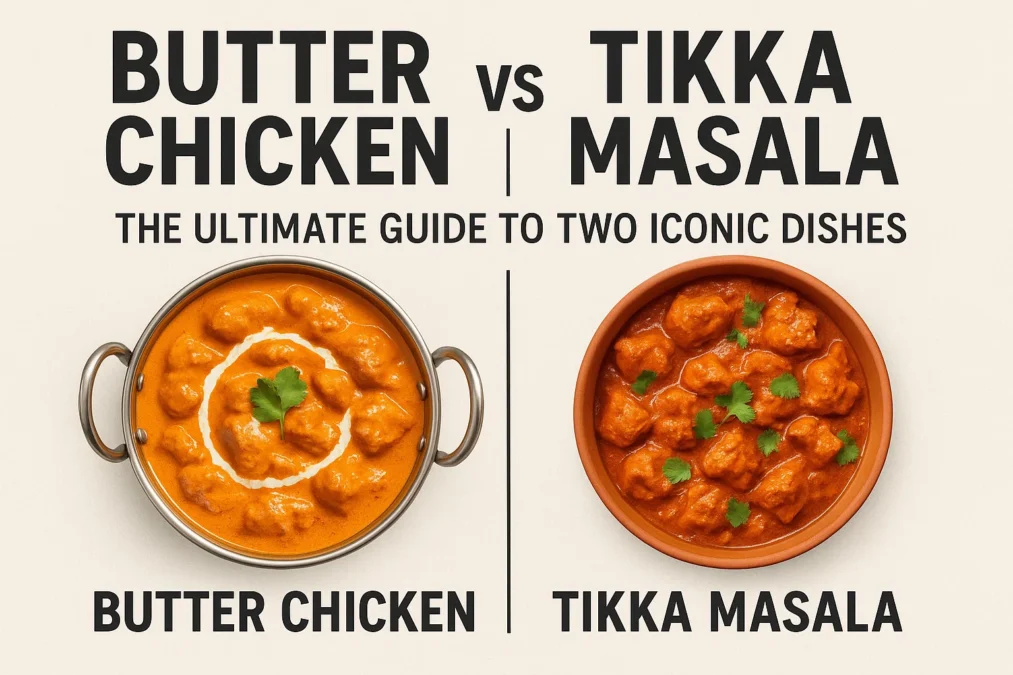Butter Chicken vs Tikka Masala: The Ultimate Guide to Two Iconic Dishes Walk into any Indian restaurant anywhere in the world, and two names will almost certainly leap out at you from the menu: butter chicken and chicken tikka masala. They are the undisputed champions of Indian cuisine, beloved for their creamy, aromatic sauces and tender, spiced meat. To the uninitiated, they might even look and sound similar—both feature chicken in a rich, tomato-based gravy. But to claim they are the same is to ignite a passionate debate among food lovers. This isn’t just a comparison of two dishes; it’s a tale of two legends, each with its own unique history, flavor profile, and cultural journey from the bustling streets of India to global superstardom.
Understanding the difference between butter chicken and tikka masala is a rite of passage for any culinary enthusiast. It’s about more than just picking a dish for dinner; it’s about appreciating the nuances of spice, the history of migration, and the art of balancing flavors. Whether you’re a die-hard fan of one or a loyalist to the other, this deep dive will enrich your knowledge and perhaps even sway your allegiance. So, let’s settle into this flavorful exploration and settle the score, once and for all, on the great butter chicken vs tikka masala debate.
The Origins and History Behind the Curries
Every great dish has a creation story, and these two are no exception. Their histories are steeped in tradition, innovation, and a bit of controversy, reflecting the complex and evolving nature of culinary culture.
The story of butter chicken, or Murgh Makhani, is widely agreed upon and deeply rooted in Delhi, India. It was invented in the 1950s by the founders of the legendary Moti Mahal restaurant. The tale goes that to avoid wasting leftover tandoori chicken, which would dry out by the end of the night, they created a rich, creamy tomato-based gravy to simmer it in. This ingenious solution not only preserved the meat but transformed it into something entirely new and sublime. The sauce was made with butter, tomatoes, cream, and a blend of aromatic spices, creating a dish that was both luxurious and comforting. Butter chicken was born from practicality and genius, a true product of North Indian culinary tradition.
The origins of chicken tikka masala, on the other hand, are far more disputed and international. The “chicken tikka” part is unequivocally Indian—it refers to chunks of boneless chicken marinated in yogurt and spices (tikka means pieces) and cooked in a tandoor. The controversy lies in the “masala” sauce. The most popular (and officially endorsed) theory attributes its invention to Bangladeshi chefs in Glasgow, Scotland, in the 1960s or 70s. As the story goes, a customer found the chicken tikka too dry and asked for some gravy. The chef, in a moment of improvisation, whipped up a sauce from a can of tomato soup, yogurt, cream, and spices. This new creation was a massive hit. Other claims point to chefs in London or even Punjab. So contentious is its origin that a British foreign secretary once jokingly declared it a “true British national dish.” This makes chicken tikka masala a fascinating example of a dish created by the Indian diaspora to cater to Western palates, a symbol of culinary adaptation and fusion.
Deconstructing the Flavor Profiles
At first glance, the sauces might appear identical, but a closer taste reveals two distinct personalities on the palate. The difference between butter chicken and tikka masala is most profoundly experienced in their flavor profiles.
Butter chicken is the epitome of comfort. Its flavor profile is rich, mild, and subtly sweet. The sauce is velvety smooth, with the sweetness of tomatoes and onions melding perfectly with the gentle warmth of spices like garam masala, cumin, and red chili powder. The generous use of butter (makhan) and fresh cream provides a luxurious, creamy base that is not overly spicy. The primary goal of butter chicken is to offer a harmonious, comforting, and decadent experience. The taste of the tandoori chicken itself, with its slight char and smokiness, is still discernible beneath the creamy blanket of sauce, creating a beautiful contrast.
Chicken tikka masala, in contrast, is generally more robust and complex in its spicing. While also creamy, the sauce tends to be tangier and brighter. This comes from a heavier reliance on tomatoes, often in the form of paste or puree, and the inclusion of ingredients like lemon juice or other tangy elements. The spice blend is more forward; you’re more likely to taste a clearer hit of paprika, cayenne, or other spices that give it a deeper, slightly sharper edge. It can range from mild to medium-hot, but its signature is a tangy, spiced creaminess that coats the tandoori chicken pieces. It’s a dish that aims to excite the taste buds with a more pronounced and vibrant flavor journey.
A Deep Dive into Ingredients and Preparation
The devil, as they say, is in the details. While the ingredient lists for these two curries have significant overlap, the specific components and their preparation methods are what create the chasm between them.
The process for making authentic butter chicken is a labor of love. It starts with marinating chicken in yogurt, lemon juice, and spices like Kashmiri red chili (for color more than heat), turmeric, and ginger-garlic paste. This chicken is then skewered and cooked in a scorching hot tandoor, acquiring its characteristic smoky flavor and slight char. The sauce is made separately by slow-cooking a large quantity of tomatoes and onions until they break down into a pulp. This is then pureed into a silky-smooth base. Spices are tempered in butter, the tomato-onion puree is added, and finally, everything is finished with copious amounts of butter and fresh cream. The pre-cooked tandoori chicken is added to this sauce just before serving to warm through, ensuring it doesn’t become tough.
The preparation for chicken tikka masala shares the first crucial step: the chicken tikka. The chicken is identically marinated and cooked in the tandoor. The divergence happens entirely with the sauce. The base for tikka masala often includes a higher proportion of tomato paste or puree, giving it a more intense tomato flavor and a brighter red color compared to the orange hue of butter chicken. The spice blend might include more potent or different spices to achieve its signature tangy and robust character. Ingredients like almond flour or coconut cream are sometimes used as thickeners in some regional variations, especially in the UK. The sauce is simmered, and the tandoori chicken is added to simmer further, allowing it to absorb more of the masala’s flavors, which is a key difference from the gentler incorporation in butter chicken.
The Great Sauce Debate: Makhani vs Masala
The heart of the butter chicken vs tikka masala comparison lies in understanding their sauces. The terms “makhani” and “masala” are the key to unlocking their identities.
“Makhani” literally translates to “with butter.” This is the defining characteristic of butter chicken’s sauce. It is a butter-based gravy. The richness and silkiness come from the dairy—butter and cream are not just additions; they are the foundation. The tomatoes provide sweetness and acidity, but they are balanced and mellowed out by the fat from the dairy. A well-made makhani sauce is incredibly smooth, mildly spiced, and feels luxurious on the tongue. It’s a sauce that coats rather than clings.
“Masala,” on the other hand, is a more generic term meaning a blend of spices. Therefore, “tikka masala” means spiced sauce for the tikka pieces. This sauce is not defined by butter as its primary ingredient. Instead, it is defined by its complex blend of spices. The cream is added for richness and to temper the heat, but the star of the show is the masala itself—the combination of spices that creates a more assertive flavor. It often has a tangier profile from ingredients like lemon, yogurt, or even mango powder (amchoor), and a deeper, more robust spice character. The sauce is typically thicker and clings more readily to the chicken and rice.
Nutritional Showdown: Which is Healthier?
In the battle of butter chicken vs tikka masala, neither can claim the title of a health food. Both are indulgent dishes designed for celebration and comfort. However, there are slight nuances that might influence your choice if you’re being calorie-conscious.
Butter chicken, true to its name, is typically the richer of the two. Its signature creaminess comes from a significant amount of butter and heavy cream, which are high in saturated fats and calories. The sauce is also often sweetened further with sugar or honey to balance the tomatoes’ acidity. While the protein from the chicken is excellent, the luxurious sauce makes it the more decadent, higher-calorie option. A single restaurant serving can easily contain a large portion of one’s daily recommended calorie and fat intake.
Chicken tikka masala can sometimes be a marginally lighter option, but this is highly variable and depends entirely on the recipe. Some versions use less cream and butter, relying more on tomato and yogurt for body and tang. However, many restaurant versions, especially outside of India, can be just as calorie-dense, with some reports suggesting certain pre-made versions contain startling amounts of sugar and fat. The chicken tikka itself is a lean protein, having been grilled in the tandoor. The nutritional downfall of both dishes lies in the sauce. Ultimately, the healthiest choice is to enjoy either in moderation or to attempt a homemade version where you can control the amount of butter, cream, and sugar used.
Cultural Impact and Global Popularity
The journey of these two dishes from their humble beginnings to global phenomenon is a testament to their universal appeal. They have become the gateway to Indian cuisine for millions around the world.
Butter chicken holds a place of pride as an authentic North Indian classic. It is a staple in restaurants across India and is often considered a safe, beloved choice for family gatherings and special occasions. Its international spread is directly tied to the diaspora of Punjabi cuisine, which is often considered the representative face of Indian food abroad. Its mildness and creamy texture make it incredibly approachable for those new to Indian flavors, acting as a gentle introduction to the world of spices. It’s a dish that represents home, tradition, and culinary authenticity for many.
Chicken tikka masala’s cultural impact is arguably even more fascinating because of its disputed origins. It is the quintessential “British Indian Restaurant” (BIR) dish and a powerful symbol of successful cultural fusion. It perfectly exemplifies how immigrant communities adapt their traditional foods to create something new that resonates deeply with the local population. Its popularity in the UK is astronomical, and from there, it spread across the globe, often becoming the most ordered dish in Indian restaurants in Western countries. It represents adaptation, innovation, and the evolving, living nature of food culture. It’s a dish that, regardless of its exact origin, tells a story of migration and creativity.
How to Choose Between Them and When to Eat Each
So, when you’re staring at the menu, how do you decide in the great butter chicken vs tikka masala dilemma? Your choice can depend on your mood, your palate, and the occasion.
Choose butter chicken when you are seeking the ultimate comfort food experience. It’s the perfect choice for a cozy night in, when you want something rich, creamy, and soothing. It’s an excellent dish for those who are sensitive to spice or are trying Indian food for the very first time. Its gentle, sweet-and-savory profile is incredibly crowd-pleasing, making it ideal for a shared meal where you need to cater to diverse tastes, including children. It pairs beautifully with a buttery garlic naan or plain basmati rice, which help to soak up every last drop of the luxurious sauce.
Opt for chicken tikka masala when you desire a dish with more vibrancy and a bolder flavor punch. If you enjoy a tangy, slightly more spiced profile and a thicker sauce that clings to the meat, this is the curry for you. It’s a fantastic choice when you want something feels more robust and complex. The stronger flavors stand up well to sides like peshwari naan (with its sweet coconut and raisin filling) or jeera rice (cumin rice). It’s the dish to order when you want to be energized and excited by your meal rather than simply comforted by it.
Cooking at Home: Tips for Mastering Both Dishes
Bringing the magic of these curries into your own kitchen is an rewarding experience. While achieving the exact tandoori smokiness without a tandoor is a challenge, a few key tips can get you remarkably close.
For butter chicken, the secret is patience. Don’t rush the cooking of the tomato and onion base; let it simmer slowly until it becomes a thick, deep-red paste. This concentrates the flavor and eliminates any raw tartness. Always puree this base until it is completely smooth for that signature velvety texture. Be generous with butter and cream, but add them at the very end, off the direct heat, to prevent the sauce from splitting. To mimic the tandoori flavor, you can add a drop of liquid smoke to the marinade or char the marinated chicken under a very hot broiler before adding it to the sauce.
For chicken tikka masala, the marinade for the chicken is non-negotiable. Let the chicken marinate for several hours, or ideally overnight, to ensure it becomes incredibly tender and flavorful. For the sauce, focus on building layers of flavor. Start by toasting your whole spices in oil, then add your ginger-garlic paste and fry until fragrant. Tomato paste is your friend here—cook it for a minute until it darkens slightly to deepen its flavor. The tang is crucial; achieve it with a touch of lemon juice or a pinch of amchoor (dried mango powder) if you can find it. Simmer the sauce well before adding the cream and cooked chicken pieces.
Nigiri vs Sashimi: A Deep Dive into Japanese Culinary Delights
Key Ingredient Variations Table
| Feature | Butter Chicken (Murgh Makhani) | Chicken Tikka Masala |
|---|---|---|
| Primary Fat Source | Butter, Cream | Oil, sometimes butter or ghee |
| Tomato Element | Fresh tomatoes, slow-cooked | Tomato paste/puree is common |
| Signature Flavor | Mild, creamy, subtly sweet | Tangy, robust, spiced |
| Spice Level | Generally very mild | Can range from mild to medium-hot |
| Color | Orangey-red | Bright red to deep red |
| Texture | Silky, smooth, pouring consistency | Thicker, clings to the chicken |
| Key Spices | Garam masala, Kashmiri chili, fenugreek | Garam masala, paprika, cumin, tangy agents |
| Chicken Preparation | Tandoori chicken added at the end | Tandoori chicken simmered in the sauce |
| Origin | Delhi, India (1950s) | Glasgow, UK (disputed) (1960s/70s) |
Quotes from the Culinary World
“Butter chicken is the original masterpiece, a dish born from tradition and zero-waste ingenuity. Tikka masala is its ambitious, globe-trotting descendant—a love letter to fusion cuisine.” — An anonymous food historian.
“The difference is in the first bite. Butter chicken comforts you; tikka masala wakes you up. One is a lullaby, the other is a pop song.” — Chef Sameer S.
“Debating butter chicken vs tikka masala is like debating two great symphonies. Both are brilliant, but they have different composers and different souls.” — Food writer Priya K.
Conclusion
In the epic and delicious showdown between butter chicken and tikka masala, there is no definitive winner—only a world of fantastic flavor to explore. Butter chicken, the authentic North Indian classic, wins hearts with its creamy, mild, and irresistibly comforting profile. It is a dish of tradition and luxury. Chicken tikka masala, the proud symbol of culinary fusion, captures attention with its tangy, robust, and more assertive spicing. It is a dish of adaptation and global appeal.
The true victory lies in understanding and appreciating each dish for what it is. Knowing the difference empowers you to choose the perfect curry for your craving, whether you need the soothing embrace of butter chicken or the vibrant kick of tikka masala. This journey through their histories, flavors, and cultures reveals that both are iconic in their own right, each telling a unique story about people, place, and the powerful, unifying language of food. So, the next time you order, you won’t just be choosing a dinner; you’ll be choosing an experience.
Frequently Asked Questions (FAQ)
What is the main difference between butter chicken and tikka masala?
The main difference lies in the sauce. Butter chicken has a milder, sweeter, and creamier sauce that is butter-based (makhani). Chicken tikka masala has a tangier, spicier, and more robust sauce that is defined by its blend of spices (masala). Think of butter chicken as comforting and luxurious, while tikka masala is more vibrant and bold.
Which is spicier, butter chicken or chicken tikka masala?
Typically, chicken tikka masala is the spicier of the two dishes. Butter chicken is famously mild and is often recommended for people who are new to Indian food or prefer no heat. Tikka masala can vary from mild to medium-hot, but it generally has a more pronounced spice kick and tanginess compared to the gentle warmth of butter chicken.
Can I make these dishes without a tandoor oven?
Absolutely! While a tandoor provides authentic smoky flavor, you can achieve excellent results at home. For the chicken, use a very hot grill, broiler, or even a heavy grill pan to get a good char. The key is in the marinade and achieving that high-heat cook. The sauces are made entirely on the stovetop, so no special equipment is needed there.
Are there vegetarian alternatives to butter chicken and tikka masala?
Yes, and they are incredibly popular. The most common vegetarian substitute is paneer (a firm Indian cheese). Paneer Tikka Masala and Paneer Makhani are staple dishes on virtually every Indian restaurant menu. You can also use vegetables like cauliflower, chickpeas, or tofu. The cooking process remains the same—the protein is marinated and grilled/roasted before being added to the respective sauce.
Why is chicken tikka masala considered a British dish?
Chicken tikka masala is considered a British dish because it was most likely invented by South Asian chefs in the United Kingdom, specifically in Scotland, to suit local tastes. While its components are Indian, the combination of grilled chicken in a creamy, spiced tomato sauce is a fusion creation that became a massive phenomenon in the UK, to the point where it is a cultural icon there.



